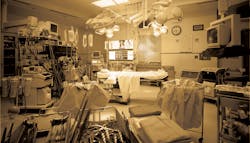Morphing equipment disposition into revenue, profit generator
Periscope
Equipment disposition has long been a problem in many healthcare systems. The responsible department varies by facility, often landing in the gray areas between the Biomedical team and the Facilities Management department.
Some systems operate their own disposition department, but by and large, many acute care facilities have a basement or warehouse full of abandoned and decommissioned equipment. The notion is that retired equipment can be sourced for replacement parts, but is this the most effective way to use decommissioned equipment?
During my recent visit to a large medical academic center in California, we walked across campus through an underground tunnel system that connects their buildings. Every underground path was lined with retired equipment. We walked among forgotten hospital beds, stretchers, mobile ECG units, shelving units and carts. The tunnels had become an equipment catacomb. There must be a better way, and there is! Those retired pieces of equipment should be viewed as a revenue stream for the facility.
5 pathways of disposition
When your equipment reaches its end-of-life within your facility, there are five ways to
retire it:
1. Disposal
2. Retain for parts
3. Donation to a charity
4. Send to Recycling Facility
5. Refurbish and resell
The first two options are mentioned only to get them out of thought and out of mind quickly! Both hard disposal and retaining old inventory for parts should always be the last resort of any facility. These options are the least cost-effective choices, especially if you are leasing warehouse space for these old assets. So how does one evaluate the best pathway for equipment, and how can systems best monetize these assets?
Your Biomed department knows how to execute this process, but do they have the resources and time to do it in real time effectively? The best way might be to find a partner that can help you with these decisions and execute the process. There are healthcare equipment distributors and other outside companies that can be recruited to help you donate, recycle and refurbish your out-of-use assets.
3 different equipment disposition processes
Equipment Buy-Back: Retired equipment is taking up space in your facility or a storage space. Contact a healthcare equipment distributor or a company that specializes in equipment disposition. They will evaluate the equipment, let you know how much you will get, and schedule a pick-up time. Freight costs should not be charged for this service.
Project-Based Equipment Disposition: You are doing an Equipment Upgrade or Replacement Project. Many times, the manufacturer or distributor that you bought the equipment from should be able to take the old equipment (for a nominal fee) at the same time they deliver the new items. If you think your old equipment has some value, call the same healthcare equipment distributor or disposition company, and they will evaluate the old equipment, make a cash offer on any equipment that is viable for resale, dispose of the rest and schedule a pick-up time convenient for you.
Full-Service Equipment Disposition Contract: You need a complete solution for all your equipment disposition needs. Customized agreement with a healthcare equipment distributor or disposition company can include the following: Timely pick-up of any retired or decommissioned equipment; evaluation of equipment at their warehouse to assess whether to refurbish and resell, donate to a designated charity, recycle at a designated recycling facility or dispose; execution of the chosen pathway; customized periodical reports itemizing disposition status and profit; and most importantly, it should include a profit-sharing opportunity.
A national IDN recently signed a contract with their healthcare equipment distributor. To date, only 30 percent of their facilities are using the service, but they have already realized close to $100,000 in shared profit. That is after actively using the contract for only five months and starting very slowly. The potential is incredible. Not only are they making a profit, but they freed up valuable space in their facilities and leased off-site warehouses.
With budgets tightening and reimbursements decreasing, this is an area that should be looked at by all healthcare systems and facilities.
About the Author
Cindy Juhas
Chief Strategy Officer
Cindy Juhas is Chief Strategy Officer for CME Corp (CME), a national full-service healthcare equipment distributor, whose mission is to help customers reduce the cost of the new equipment they purchase, and make their equipment specification, delivery, installation, maintenance and disposal processes more efficient. CME offers a full array of logistical, biomedical and technical services to serve their healthcare partners. She can be reached at [email protected].
